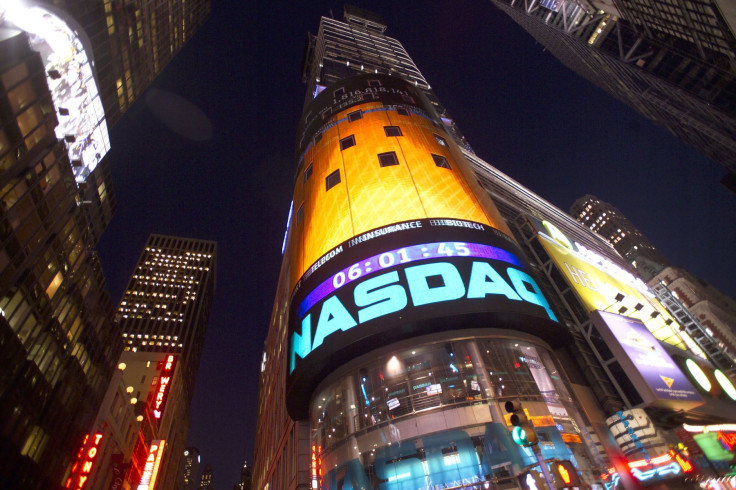Nasdaq Composite Breaks All-Time High Set During Dot-com Bubble In 2000

U.S. stocks traded sharply higher Thursday, with the Nasdaq composite soaring past its all-time record set during the peak of the dot-com bubble era. The gains were driven by the biotechnology sector, pushing the Nasdaq above its intraday record high of 5,132.52, previously set on March 10, 2000.
In afternoon trading, the Dow Jones Industrial Average (INDEXDJX:.DJI) gained 205.79 points, or 1.15 percent, to 18,141.53. The Standard & Poor’s 500 index (INDEXNASDAQ:.IXIC) added 21.85 points, or 1.04 percent, to 2,122.29. The Nasdaq composite (INDEXSP:.INX) rose 69.41 points, or 1.37 percent, to 5,143.32.
Though technology companies are powering the Nasdaq's current upward trajectory just as they did in 2000, the index itself looks very different a decade and a half later. The Nasdaq was much different in 2000 because it mostly comprised Internet stocks; however, now the index has broader listings, including biotechnology and healthcare companies.
Technology still makes up around 42 percent of the Nasdaq composite, but the sector was nearly 57 percent of the index at the height of the tech bubble in 2000. The Nasdaq now has sizable positions in healthcare, which previously contributed only 4 percent 15 years earlier compared with 16 percent now.
There has been continued strength so far this year in the Nasdaq’s biotechnology sector, which has gained more than 20 percent since January. The Nasdaq Composite gained 1 percent Thursday, driven by a 2.5 percent gain in the iShares Nasdaq Biotechnology exchange traded fund, which tracks companies such as Gilead Sciences Inc. (NASDAQ:GILD), Amgen, Inc. (NASDAQ:AMGN) and Biogen Inc. (NASDAQ:BIIB).
“People wanted to take risks then because they believe in the story how the Internet was going to change the world. More people now are rationalizing higher valuations because interest rates are low so they need to find returns,” Srinivas Thiruvadanthai, director of research at the Jerome Levy Forecasting center, told International Business Times in March.
Shares of Fitbit Inc. (NYSE:FIT) soared more than 50 percent Thursday after the maker of wearable health-tracking devices made its stock market debut, opening at $30.40, 52 percent above its initial public offering price of $20. The IPO values the company at more than $4 billion.
The Dow Jones Industrial Average leaped more than 200 points in afternoon trading, a day after the Federal Reserve kept interest rates unchanged this week. Dow components Boeing Co. (NYSE:BA) and 3M Co. (NYSE:MMM) led the blue-chip index higher Thursday, both adding 2 percent.
U.S. stocks continued to rally following a report that Greece’s bailout will be extended until the end of the year, without the participation of the International Monetary Fund, Germany’s Die Zeit reported.
The Fed kept its economic projections for interest rates unchanged this week, but signaled the central bank is on track to raise rates in September after the central bank’s quarterly update showed the majority of policy makers see two rate hikes this year, despite the disappointingly slow growth in the first half of this year.
However, the Federal Open Market Committee (FOMC) members lowered their median forecasts for interest rates in 2016 and 2017, underscoring the trajectory for the Fed lifting rates should be slow and cautious.
“The fact that the FOMC held steady on its rate expectations, despite disappointingly weak economic data in the first quarter, is significant and was likely meant to send a clear message to the markets that rates will probably rise this year,” Kathy Bostjancic, director of U.S. macro investor services at Oxford Economics, said in a research note.
Data released Thursday showed the consumer price index rose 0.4 percent in May to its highest level since February 2013, led by higher energy prices, the Labor Department said Thursday. The rise in the index signals inflation is stabilizing after being muted following a plunge in energy prices last year.
Inflation continues to run below the central bank’s 2 percent target, as it has for more than 30 consecutive months, and central bankers have maintained they need to have “confidence in the outlook” that inflation will return to the central bank’s 2 percent target.
However, economists expect the price of oil to stabilize from a year ago by the end of the year, allowing time for inflation to start picking up. Experts say the nonenergy parts of the index, such as the shelter components, are forecast to rise closer to 2 percent by the end of the year from a year earlier.
That means energy will be a less volatile component on the headline consumer price index.
“That’s important because Chair [Janet] Yellen and other Fed members have not stated that they need inflation to return back to normal to be confident in raising rates. They just need to be convinced that we’re headed back there,” said Luke Tilley, chief economist at Wilmington Trust.
Gus Faucher, senior macro economist at PNC Financial Services Group, agrees. “With energy prices increasing, inflation will accelerate over the next few months. This will give the FOMC the confidence to raise the Fed funds rate target at their September meeting,” Faucher said in a research note.
© Copyright IBTimes 2025. All rights reserved.




















